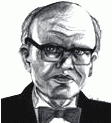Jack Kilby
Although he has over 60 patents to his credit, Jack Kilby would justly be considered one of the greatest electrical engineers of all time for one invention: the monolithic integrated circuit, or microchip (patent #3,138,743). The microchip made microprocessors possible, and therefore allowed high-speed computing and communications systems to become efficient, convenient, affordable, and ubiquitous.
Some time after earning a BS in Electrical Engineering at the University of Illinois (1947) and an MS in Electrical Engineering at the University of Wisconsin (1950), Kilby took a research position with Texas Instruments, Inc. in Dallas, Texas (1958). Within a year, Kilby had conceived and created what no engineer had thought possible: a small, self-contained, "monolithic" integrated circuit, in a single piece of semiconductor material about the size of a fingernail. At the first professional presentation of his invention, the Institute of Radio Engineers (IRE) Show of 1959, Kilby's colleagues were both astonished and overjoyed by his creation, and the "fourth generation" of computers was born.
Kilby went on to develop the first industrial, commercial, and military applications for his integrated circuits, including the first pocket calculator (the "Pocketronic") and the computer that used them. By the mid-1970s, the computing industry was inconceivable without the microchip, which forms the basis of modern microelectronics. Without it, no personal computer, fax machine, cellular phone, satellite television, or indeed any other computer or mass communication system as we know it would exist.
An independent inventor and consultant since 1970, Kilby had used his own success to promote other engineers and inventors, most notably by establishing the Kilby Awards Foundation, which annually honors individuals outstanding in science, technology, and education. Jack Kilby was admired as much for his generosity as he was for his genius. In 2000, he was awarded the Nobel Prize in Physics.
Kilby passed away on June 20th, 2005.


